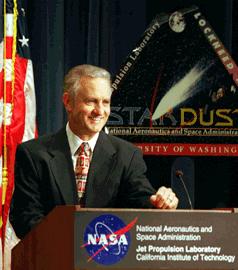STARDUST Status Report
February 19, 1999

Ken
Atkins
STARDUST Project Manager
STARDUST continues to demonstrate excellent flight performance.
The Cruise 1 mission phase bit was set on February 16. Today, the data rate
was set to 1050 bits/sec. In additiion, the Dust Flux Monitor Instrument (DMFI)
was turned on and initial data downlinked and forwarded to the University
of Chicago for evaluation. Recall that the DFMI is the instrument that is
located on the shield inside the launch adapter ring. It will be
registering impacts by particles as we fly through the comet to give the
science team an indication of the number and size of particles in the dust
stream. Dr. Tony Tuzzolino is the Co-Investigator who provided the
instrument. Dr. Tuzzolino's "quick look" indicates the DFMI is working
properly. Better information will come from the University of Chicago's
detailed analysis in the days ahead.
Preparations have been now been completed for transitioning to Mission
Sequence Cruise 1 and for powering the Cometary and Interstellar Dust Analyzer
(CIDA) next week. As expected, the planned first trajectory correction
maneuver (TCM-1) was canceled today although Navigation will continue
analysis of tracking data to complete the understanding of small forces
effects. The cancellation of the maneuver was possible because of the
accuracy of the initial trajectory injection by the Delta II rocket. I
understand it's unprecedented to get such a good "shot" off the launch
vehicle. It's great to "fly Boeing!" What a spectacular view that 2nd
stage camera provided of the ride to space. It certainly attracted a lot
of press coverage for STARDUST.
For more information on the STARDUST mission - the first ever comet sample
return mission - please visit the STARDUST home page:
http://stardust.jpl.nasa.gov
